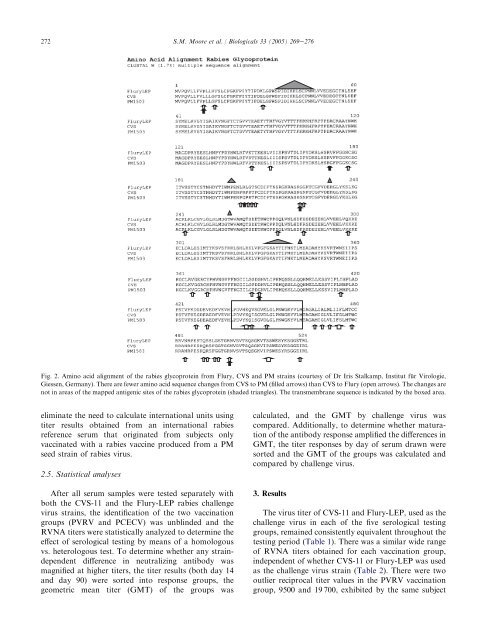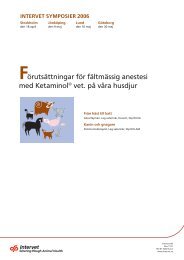KVÄLLSSYMPOSIUM 2008 Vaccinering av hund och katt
KVÄLLSSYMPOSIUM 2008 Vaccinering av hund och katt
KVÄLLSSYMPOSIUM 2008 Vaccinering av hund och katt
You also want an ePaper? Increase the reach of your titles
YUMPU automatically turns print PDFs into web optimized ePapers that Google loves.
272 S.M. Moore et al. / Biologicals 33 (2005) 269e276<br />
Fig. 2. Amino acid alignment of the rabies glycoprotein from Flury, CVS and PM strains (courtesy of Dr Iris Stalkamp, Institut fu¨r Virologie,<br />
Giessen, Germany). There are fewer amino acid sequence changes from CVS to PM (filled arrows) than CVS to Flury (open arrows). The changes are<br />
not in areas of the mapped antigenic sites of the rabies glycoprotein (shaded triangles). The transmembrane sequence is indicated by the boxed area.<br />
eliminate the need to calculate international units using<br />
titer results obtained from an international rabies<br />
reference serum that originated from subjects only<br />
vaccinated with a rabies vaccine produced from a PM<br />
seed strain of rabies virus.<br />
2.5. Statistical analyses<br />
After all serum samples were tested separately with<br />
both the CVS-11 and the Flury-LEP rabies challenge<br />
virus strains, the identification of the two vaccination<br />
groups (PVRV and PCECV) was unblinded and the<br />
RVNA titers were statistically analyzed to determine the<br />
effect of serological testing by means of a homologous<br />
vs. heterologous test. To determine whether any straindependent<br />
difference in neutralizing antibody was<br />
magnified at higher titers, the titer results (both day 14<br />
and day 90) were sorted into response groups, the<br />
geometric mean titer (GMT) of the groups was<br />
calculated, and the GMT by challenge virus was<br />
compared. Additionally, to determine whether maturation<br />
of the antibody response amplified the differences in<br />
GMT, the titer responses by day of serum drawn were<br />
sorted and the GMT of the groups was calculated and<br />
compared by challenge virus.<br />
3. Results<br />
The virus titer of CVS-11 and Flury-LEP, used as the<br />
challenge virus in each of the five serological testing<br />
groups, remained consistently equivalent throughout the<br />
testing period (Table 1). There was a similar wide range<br />
of RVNA titers obtained for each vaccination group,<br />
independent of whether CVS-11 or Flury-LEP was used<br />
as the challenge virus strain (Table 2). There were two<br />
outlier reciprocal titer values in the PVRV vaccination<br />
group, 9500 and 19 700, exhibited by the same subject





